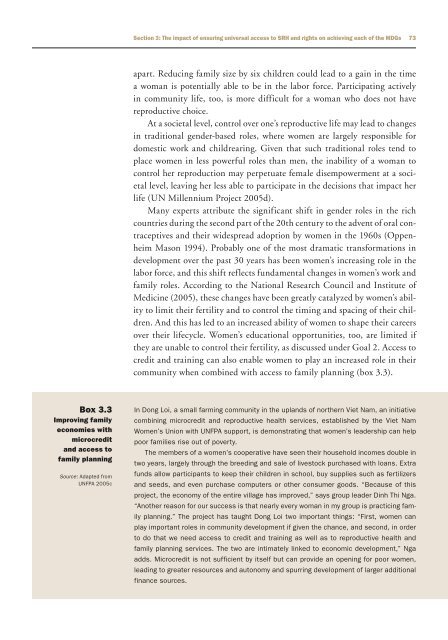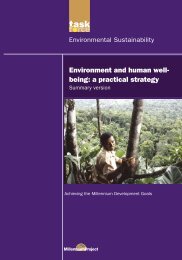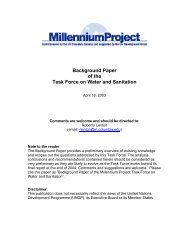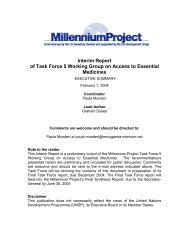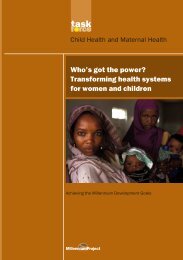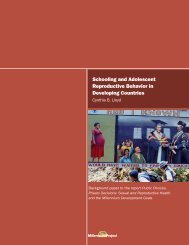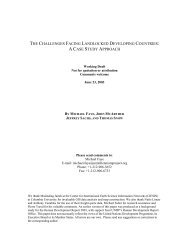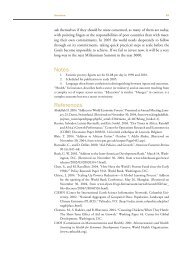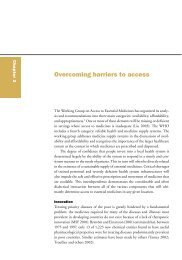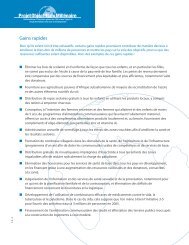Public Choices, Private Decisions: Sexual and Reproductive Health ...
Public Choices, Private Decisions: Sexual and Reproductive Health ...
Public Choices, Private Decisions: Sexual and Reproductive Health ...
You also want an ePaper? Increase the reach of your titles
YUMPU automatically turns print PDFs into web optimized ePapers that Google loves.
Section 3: The impact of ensuring universal access to SRH <strong>and</strong> rights on achieving each of the MDGs<br />
73<br />
apart. Reducing family size by six children could lead to a gain in the time<br />
a woman is potentially able to be in the labor force. Participating actively<br />
in community life, too, is more difficult for a woman who does not have<br />
reproductive choice.<br />
At a societal level, control over one’s reproductive life may lead to changes<br />
in traditional gender-based roles, where women are largely responsible for<br />
domestic work <strong>and</strong> childrearing. Given that such traditional roles tend to<br />
place women in less powerful roles than men, the inability of a woman to<br />
control her reproduction may perpetuate female disempowerment at a societal<br />
level, leaving her less able to participate in the decisions that impact her<br />
life (UN Millennium Project 2005d).<br />
Many experts attribute the significant shift in gender roles in the rich<br />
countries during the second part of the 20th century to the advent of oral contraceptives<br />
<strong>and</strong> their widespread adoption by women in the 1960s (Oppenheim<br />
Mason 1994). Probably one of the most dramatic transformations in<br />
development over the past 30 years has been women’s increasing role in the<br />
labor force, <strong>and</strong> this shift reflects fundamental changes in women’s work <strong>and</strong><br />
family roles. According to the National Research Council <strong>and</strong> Institute of<br />
Medicine (2005), these changes have been greatly catalyzed by women’s ability<br />
to limit their fertility <strong>and</strong> to control the timing <strong>and</strong> spacing of their children.<br />
And this has led to an increased ability of women to shape their careers<br />
over their lifecycle. Women’s educational opportunities, too, are limited if<br />
they are unable to control their fertility, as discussed under Goal 2. Access to<br />
credit <strong>and</strong> training can also enable women to play an increased role in their<br />
community when combined with access to family planning (box 3.3).<br />
Box 3.3<br />
Improving family<br />
economies with<br />
microcredit<br />
<strong>and</strong> access to<br />
family planning<br />
Source: Adapted from<br />
UNFPA 2005c<br />
In Dong Loi, a small farming community in the upl<strong>and</strong>s of northern Viet Nam, an initiative<br />
combining microcredit <strong>and</strong> reproductive health services, established by the Viet Nam<br />
Women’s Union with UNFPA support, is demonstrating that women’s leadership can help<br />
poor families rise out of poverty.<br />
The members of a women’s cooperative have seen their household incomes double in<br />
two years, largely through the breeding <strong>and</strong> sale of livestock purchased with loans. Extra<br />
funds allow participants to keep their children in school, buy supplies such as fertilizers<br />
<strong>and</strong> seeds, <strong>and</strong> even purchase computers or other consumer goods. “Because of this<br />
project, the economy of the entire village has improved,” says group leader Dinh Thi Nga.<br />
“Another reason for our success is that nearly every woman in my group is practicing family<br />
planning.” The project has taught Dong Loi two important things: “First, women can<br />
play important roles in community development if given the chance, <strong>and</strong> second, in order<br />
to do that we need access to credit <strong>and</strong> training as well as to reproductive health <strong>and</strong><br />
family planning services. The two are intimately linked to economic development,” Nga<br />
adds. Microcredit is not sufficient by itself but can provide an opening for poor women,<br />
leading to greater resources <strong>and</strong> autonomy <strong>and</strong> spurring development of larger additional<br />
finance sources.


